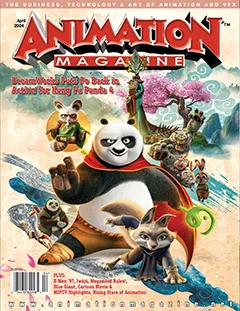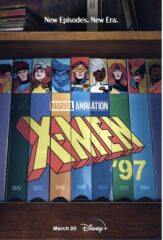|
Getting your Trinity Audio player ready...
|
If you were a kid during the 1990s, odds are any mention of X-Men: The Animated Series instantly ignites your brain with that iconic theme song and title sequence. So, the X-Men ’97 revival and continuation of the beloved series that’s arriving on Disney+ this month must include or re-create that experience in some way, right?
Let’s back up! X-Men: The Animated Series was a runaway Saturday morning cartoon hit from the moment it debuted in October 1992 through its 76th and final episode in 1997. Jampacked with stories and relationships developed in the Marvel comic-book series created in 1963 by Stan Lee and Jack Kirby, X-Men: The Animated Series remains iconic for an entire generation of fans. As ’90s nostalgia grows, along with anticipation for the X-Men’s arrival in the Marvel Cinematic Universe, reviving the series instead of rebooting it seems a natural move.
“It was the concept from the beginning that that we wanted to, to the best of our ability, emulate the OG series,” says Brad Winderbaum, a 15-year Marvel Studios veteran and executive producer on X-Men ’97, which will have a 10-episode first season.

Forever Fans
Immediately on board was Beau DeMayo, a die-hard fan of the original series who is serving as executive producer, showrunner and head writer on the series. DeMayo credits much of the original show’s success to Eric Lewald, who developed the series for TV and served as story editor with his wife, Julia; and Larry Houston, who directed 69 of the show’s 76 episodes. (The Lewalds wrote two books that helped revive interest in the show.) “I don’t think it’s an overstatement to say the Lewalds and Larry Houston are the grandparents of the MCU,” DeMayo says.
The original series thrived despite its extremely tight budget and time constraints by cramming as much story as possible into each episode — an experience that helped audiences overlook some of the seams in the animation work while perfectly capturing the frenetic style that had made X-Men comics so popular.
‘I think it’s very smart to bring this show back to take us back to the core truths about who these characters are, before then seeing how they enter the MCU in a larger capacity.’
— Exec producer and showrunner Beau DeMayo
For DeMayo, however, the real key to the show is in the characters’ relationships and the human drama, rather than the toyetic approach common at the time for animated adventure shows.
“It’s the melodrama,” he says. “We will have the cool powers and villains, but at the end of the day you’re more curious about why Apocalypse rearing his evil head complicates Jean and Scott’s marriage more than you are about what is Apocalypse trying to do and how are they going to beat him.”
It’s been fun to bring back the series’ sunny 1990s outlook on mutant-human relations in our more complicated times, even when it presents problems. DeMayo says the new show doesn’t apologize for being quintessentially ’90s, even when it at times is awkward in ways he generously describes as “cozy.” “Storm will always announce her moves; Rogue is always going to have the syrupy metaphor,” he says.
 Some characters presented more difficulties than others. Jubilee was especially difficult because young people today don’t act the same as they did in the 1990s, so her character can’t fill the same function. For Beast, DeMayo drew on his experience writing for Star Trek: Strange New Worlds and put in placeholders for the character’s scientific jargon. A similar problem emerged for Rogue, whose knack for Southern metaphors and analogies didn’t come as easily to DeMayo.
Some characters presented more difficulties than others. Jubilee was especially difficult because young people today don’t act the same as they did in the 1990s, so her character can’t fill the same function. For Beast, DeMayo drew on his experience writing for Star Trek: Strange New Worlds and put in placeholders for the character’s scientific jargon. A similar problem emerged for Rogue, whose knack for Southern metaphors and analogies didn’t come as easily to DeMayo.
“Those tend to stop a scene every once in a while for me as I’m writing,” he says. “[She] surprised me not in terms of difficulty, but just her character emerged in Season One in a way that I did not expect when I first conceived of the season.”
Bolstering the revival’s credibility with fans is the return of a large portion of the original voice cast, including Cal Dodd as Wolverine, Alison Sealy-Smith as Storm, Lenore Zann as Rogue, Chris Potter as Gambit, George Buza as Beast and Catherine Disher as Jean Grey. (Alyson Court gave up the role of Jubilee because she thought an Asian actor should voice the character, but Court has other roles in the new version.)

The look of the show is equally important, and creating something that both evokes the original and meets modern audiences’ expectations requires an approach that director Jake Castorena describes as fresh but familiar.
“It needs to be the show we remember, but it has to be in 4K, because the reality is we’ve learned so much just in the art form of TV animation itself — from what works, what doesn’t work, technical advancements, production advancements, artistic advancements,” he says. “To do the show, verbatim, as it was, it would be difficult to stay relevant.”
‘It needs to be the show we remember, but the reality is we’ve learned so much just in the art form of TV animation itself. To do the show, verbatim, as it was, it would be difficult to stay relevant.’
— Director Jake Castorena
That’s where studying the original series and finding out what made it tick helped set a course for the new show’s visuals. “It’s who do you cut to and when,” he says. “Just because Scott is doing team leader [stuff] and he’s saying his thing doesn’t mean we’re not [focusing] on Jean worrying about whatever they’re going through at the moment.”
Although there may be a temptation to limit the animation to evoke the ’90s style, Castorena says it’s more easily achieved with other techniques.
“If we put too many bells and whistles and did all the new fancy things that we can do with technology, it wouldn’t be the show you remember,” he says. The answer was less about technology and more about how the show was storyboarded. “It’s a lot about compositions and lenses, trying to adhere to what was cinematically being done at the time.”

That includes some interesting little tricks, Winderbaum says. “Part of the design of the overall look of the show is to create a small video transfer effect over the animation to give it a little bit of that television in the ’90s patina,” he says.
Evoking memory with those techniques also makes it possible to occasionally break the rules and open up the action in ways the original series could not. “We have a strict code of ethics,” says Winderbaum. “But there are specific points where we crack it on purpose for what I think is great dramatic effect.”

Core Truths and the Future
With a second season already on order and the X-Men poised to enter the Marvel Cinematic Universe — perhaps as early as this summer’s Deadpool & Wolverine — the future looks bright for the X-Men.
“I think it’s very smart to bring this show back to take us back to the core truths about who these characters are … why we fell in love with them in the first place, before then seeing how they enter the MCU in a larger capacity,” DeMayo says.
But what everyone still wants to know is whether they’ll re-create that opening title sequence and use the original theme song. Winderbaum confirms Larry Houston directed the new show’s opening sequence. Castorena adds: “I feel we’re doing it right. And if you want to do things right, there are just certain things you may or may not have to include.”
DeMayo also won’t confirm but gives fans hope: “Everyone knows what that theme means to people, what that main title means to people. And we are big believers over here of not setting ourselves up for failure.”
X-Men 97 will premiere on Disney+ on March 20. A new episode debuts each week.
Tom McLean is a lifelong X-Men fan and author of Mutant Cinema: The X-Men Trilogy from Comics to Screen, published by Sequart.









 Win a Funko X Lilo & Stitch Prize Pack!
Win a Funko X Lilo & Stitch Prize Pack!

